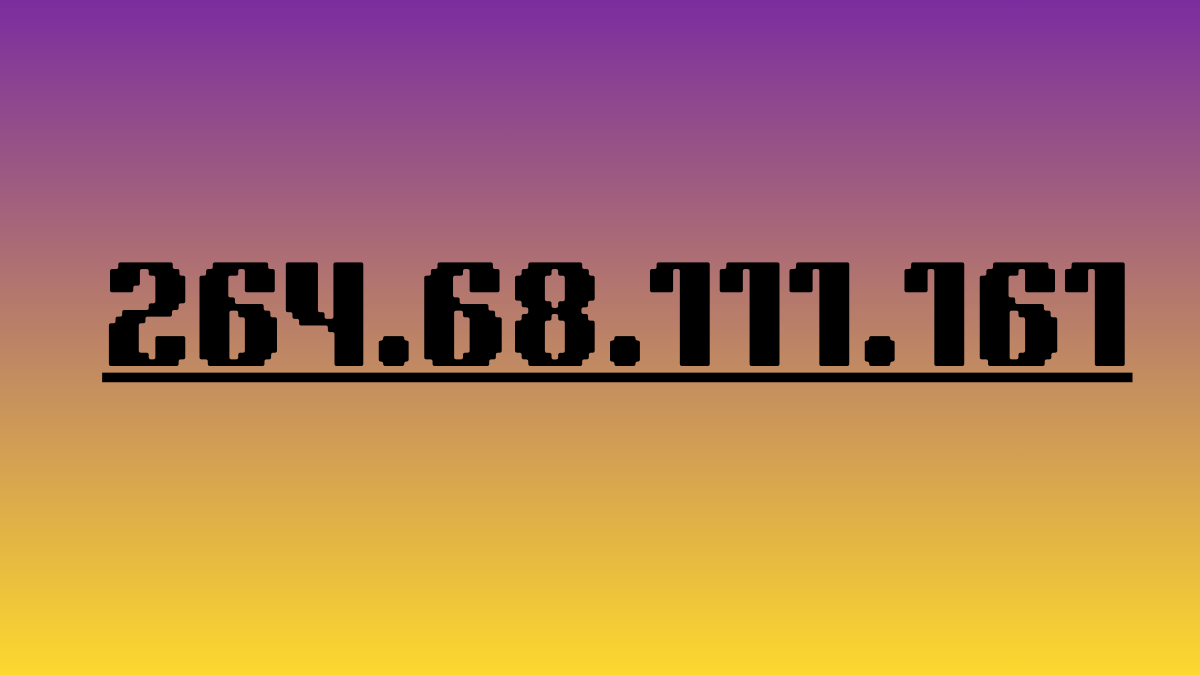264.68.111.161 – Meaning, Usage, and Everything You Need to Know
Learn about 264.68.111.161, its purpose, technical background, and practical usage. This guide covers details, FAQs, and insights in simple terms for better understanding.
also read: https://theplaycentreorg.com/prostavive-colibrim/
Introduction
The internet is built on a massive structure of numbers, addresses, and protocols that allow devices around the globe to communicate with each other. One such example is the IP address 264.68.111.161. At first glance, it looks like a random string of digits, but like every IP address, it carries technical significance.
This article explains everything about 264.68.111.161, including what it means, how IP addresses work, the importance of such numbers in networking, and whether this particular address has any real-world applications. If you have come across 264.68.111.161 while browsing logs, studying networking, or out of curiosity, this article will help clarify its context.
Understanding the Basics of IP Addresses
Before diving into the specifics of 264.68.111.161, it’s essential to understand what an IP address is.
An IP address (Internet Protocol address) is a unique number assigned to every device connected to the internet or a network. It acts like a digital identifier, ensuring that information gets sent to the correct destination.
There are two main versions of IP addresses in use today:
- IPv4 (Internet Protocol version 4):
- Uses four sets of numbers separated by dots (like 192.168.1.1).
- Each set can range between 0–255.
- Supports about 4.3 billion unique addresses.
- IPv6 (Internet Protocol version 6):
- Uses a longer format with hexadecimal values.
- Created to solve IPv4 exhaustion.
- Provides trillions of unique addresses.
The address 264.68.111.161 appears to be formatted as an IPv4 address. However, it contains a clue that something might be off.
Is 264.68.111.161 a Valid IP Address?
Here’s the key detail: IPv4 addresses have a strict numerical rule. Each of the four segments (octets) must range from 0 to 255.
Let’s break down 264.68.111.161:
| Octet Position | Value | Valid Range (0–255)? |
|---|---|---|
| 1st Octet | 264 | ❌ Invalid (above 255) |
| 2nd Octet | 68 | ✅ Valid |
| 3rd Octet | 111 | ✅ Valid |
| 4th Octet | 161 | ✅ Valid |
As you can see, the first octet, 264, is outside the valid range of 0–255. This means that 264.68.111.161 is not a valid IPv4 address.
So, why does this number exist, and why do people look it up?
Possible Reasons You Encounter 264.68.111.161
Even though 264.68.111.161 isn’t a valid IPv4 address, it can still appear in different contexts. Here are some possibilities:
1. Typographical Error
One of the most common reasons is a typing mistake. Someone might have intended to enter an IP like 164.68.111.161 or 24.68.111.161, but accidentally added the digit 2 in the wrong place.
2. Example or Placeholder Address
Sometimes networking guides or documentation use made-up IP addresses to demonstrate examples. It’s possible that 264.68.111.161 was inserted for illustrative purposes but not meant to represent a functional IP.
3. Misconfigured Systems
In rare cases, system logs or software applications may incorrectly record addresses due to bugs, leading to invalid outputs like 264.68.111.161.
4. Curiosity and Search Queries
Since IP addresses look technical and mysterious, people often copy-paste them into search engines to find meaning. That explains why 264.68.111.161 pops up online.
The Difference Between Valid and Invalid IPs
To avoid confusion, let’s compare valid and invalid examples side by side.
| Example IP | Valid/Invalid | Reason |
|---|---|---|
| 192.168.0.1 | ✅ Valid | Common private IPv4 address |
| 255.255.255.255 | ✅ Valid | Broadcast address |
| 264.68.111.161 | ❌ Invalid | Octet exceeds 255 |
| 300.10.20.30 | ❌ Invalid | Octet exceeds 255 |
By looking at the table, it becomes clear that 264.68.111.161 falls into the invalid category.
How to Spot Mistyped IP Addresses
Mistyping IP addresses can cause failed connections or wasted troubleshooting time. Here are some tips to spot issues:
- Always check if each number (octet) is between 0–255.
- If an IP fails to connect, verify it wasn’t copied incorrectly.
- Use online IP validation tools to confirm whether an address is real.
- Keep in mind that IPv6 looks very different, so don’t confuse the two.
Why Invalid IPs Like 264.68.111.161 Matter
Even though 264.68.111.161 isn’t technically usable, studying such cases is valuable for learning. For example:
- Networking Students: It teaches beginners to recognize errors in address formats.
- System Administrators: It highlights the importance of log accuracy.
- Cybersecurity Professionals: Invalid IPs may appear in attack logs, helping identify anomalies.
Related Valid IP Ranges
If you were originally searching for 264.68.111.161, chances are you may have intended to look up something similar, such as:
- 164.68.111.161 – A valid IPv4 address often linked to real servers.
- 24.68.111.161 – Another valid address that may belong to an ISP.
To verify the authenticity of an IP, you can perform a WHOIS lookup, ping test, or check its geolocation data.
Frequently Asked Questions
Here are 10 additional FAQs to provide more clarity and value around this topic:
1. What is the main issue with 264.68.111.161?
The first octet “264” exceeds the valid range (0–255), making it invalid as an IPv4 address.
2. Can 264.68.111.161 be used in IPv6 format?
No, IPv6 addresses follow a completely different format using hexadecimal characters, not four decimal octets.
3. Is 264.68.111.161 a private or public IP?
It is neither. Since it is invalid, it cannot be classified as private or public.
4. Why do some websites list 264.68.111.161?
They may use it as an example, or it may be the result of a typographical or system error.
5. How can I validate whether an IP address is real?
You can use online tools, ping commands, or check if all octets are within 0–255.
6. Could 264.68.111.161 belong to any device?
No, devices cannot use this address since it falls outside the valid IPv4 range.
7. What happens if you try to connect to 264.68.111.161?
Your system will return an error, as it is not a valid destination on the internet.
8. Is it safe to search for 264.68.111.161?
Yes, looking up invalid IPs like this is harmless. However, connecting to unknown valid IPs should be done cautiously.
9. What tools can help analyze IP addresses?
Common tools include WHOIS lookup, traceroute, ping, nslookup, and online IP checkers.
10. Could 264.68.111.161 appear in a hacking attempt?
Yes, attackers sometimes generate fake or invalid IPs to confuse logs, though this specific address itself isn’t dangerous.
Conclusion
The string 264.68.111.161 may look like an ordinary IP address, but upon closer inspection, it isn’t valid because the first octet exceeds the IPv4 range. While it cannot represent an actual device on the internet, its presence in logs, tutorials, or searches highlights the importance of understanding how IP addresses work.
By knowing why 264.68.111.161 is invalid, you gain deeper insight into the structure of IPs, how to spot errors, and why accuracy is critical in networking. Whether you’re a student, IT professional, or simply curious, recognizing invalid IPs helps sharpen your technical awareness.
also read: https://theplaycentreorg.com/rapelusr/
also read: https://theplaycentreorg.com/doodflix-everything-you-need-to-know-about-the-streaming-platform/
also read: https://theplaycentreorg.com/newtopy/
also read: https://theplaycentreorg.com/nhentai-nef/
also read: https://theplaycentreorg.com/hcooch-ch2-h2o/
also read: https://theplaycentreorg.com/zvideo/
also read: https://theplaycentreorg.com/%d9%87%d9%86%d8%aa%d8%a7%d9%88%d9%8a-com/
news via inbox
Mail us for latest news and updates







